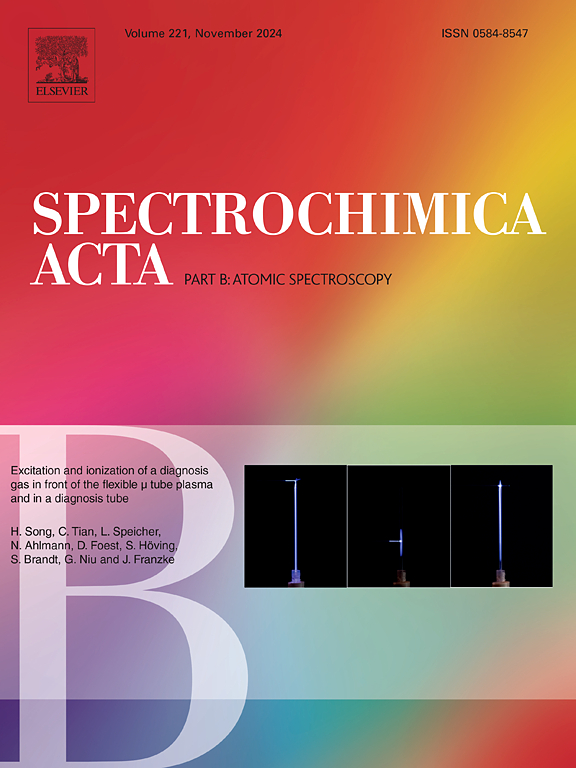Effect of Ar on parameters of nitrogen microwave-induced plasma optical emission spectrometry
IF 3.2
2区 化学
Q1 SPECTROSCOPY
引用次数: 0
Abstract
The effect of Ar content in the range of 0–100 % was studied separately in the outer, intermediate and nebulizer gas flow on the excitation temperature and electron density, the intensity of element lines and the molecular background in a N2 microwave induced plasma. The addition of Ar to the nebulizer flow leads to an increase in the intensities of both atomic and ionic lines with total excitation energies (Esum) 3–13 eV to 1.7 times, depending on the selected line. Addition to the outer or intermediate flow shifts the atomic-ionic equilibrium towards the formation of ions. As a result, the intensity of ionic lines (Esum = 10–13 eV) increases up to 1.2 times, the decrease in the intensity of atomic lines (Esum = 3–6 eV) reaches up to 20 %. The excitation temperature and electron density in the plasma did not change significantly regardless of which flow the argon was fed into. The intensity of the molecular components of the plasma background (OH, NH, NO) changes significantly when Ar is introduced into the nebulizer flow. The OH intensity increases to 1.8 times, and NH intensity increases to 1.5 times at 100 % Ar relative to pure N2 plasma. Supplying 100 % Ar simultaneously into the intermediate and nebulizer gas flow and N2 into the outer flow allows one to reduce the limits of detection by up to 3.3 times, depending on the selected spectral line of the element.

氩对氮微波等离子体发射光谱参数的影响
分别研究了外、中、雾化器气流中Ar含量在0 ~ 100%范围内对N2微波诱导等离子体中激发温度、电子密度、元素谱线强度和分子背景的影响。在雾化器流中加入Ar会导致总激发能(Esum)为3-13 eV的原子和离子线的强度增加到1.7倍,这取决于所选择的线。除了外部或中间流动外,原子-离子平衡向离子形成方向转移。结果表明,离子谱线(Esum = 10 ~ 13 eV)的强度提高了1.2倍,原子谱线(Esum = 3 ~ 6 eV)的强度降低了20%。等离子体内的激发温度和电子密度在不同的氩气流中没有明显的变化。当氩气进入雾化器流中时,等离子体背景分子组分(OH, NH, NO)的强度发生了显著变化。与纯N2等离子体相比,在100% Ar条件下,OH强度增加到1.8倍,nhh强度增加到1.5倍。根据所选元素的谱线,同时向中间和雾化器气体流中提供100%的Ar,并向外部流中提供N2,可以将检测极限降低3.3倍。
本文章由计算机程序翻译,如有差异,请以英文原文为准。
求助全文
约1分钟内获得全文
求助全文
来源期刊
CiteScore
6.10
自引率
12.10%
发文量
173
审稿时长
81 days
期刊介绍:
Spectrochimica Acta Part B: Atomic Spectroscopy, is intended for the rapid publication of both original work and reviews in the following fields:
Atomic Emission (AES), Atomic Absorption (AAS) and Atomic Fluorescence (AFS) spectroscopy;
Mass Spectrometry (MS) for inorganic analysis covering Spark Source (SS-MS), Inductively Coupled Plasma (ICP-MS), Glow Discharge (GD-MS), and Secondary Ion Mass Spectrometry (SIMS).
Laser induced atomic spectroscopy for inorganic analysis, including non-linear optical laser spectroscopy, covering Laser Enhanced Ionization (LEI), Laser Induced Fluorescence (LIF), Resonance Ionization Spectroscopy (RIS) and Resonance Ionization Mass Spectrometry (RIMS); Laser Induced Breakdown Spectroscopy (LIBS); Cavity Ringdown Spectroscopy (CRDS), Laser Ablation Inductively Coupled Plasma Atomic Emission Spectroscopy (LA-ICP-AES) and Laser Ablation Inductively Coupled Plasma Mass Spectrometry (LA-ICP-MS).
X-ray spectrometry, X-ray Optics and Microanalysis, including X-ray fluorescence spectrometry (XRF) and related techniques, in particular Total-reflection X-ray Fluorescence Spectrometry (TXRF), and Synchrotron Radiation-excited Total reflection XRF (SR-TXRF).
Manuscripts dealing with (i) fundamentals, (ii) methodology development, (iii)instrumentation, and (iv) applications, can be submitted for publication.

 求助内容:
求助内容: 应助结果提醒方式:
应助结果提醒方式:


